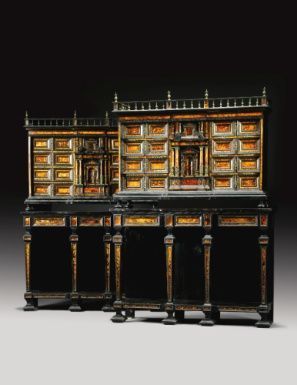A pair of Italian tortoiseshell, ebony veneered and ebonised cabinets, Sicilian late 17th/early 18th century and later
A pair of Italian tortoiseshell, ebony veneered and ebonised cabinets, Sicilian late 17th/early 18th century and later - Photo Sotheby's
each of architectural form, with a later gilt-bronze balustraded gallery with baluster urn finials above an architectural niche flanked by two pairs of columns opening to reveal a fitted interior flanked on either side by four panelled drawers, the later stand with a panelled frieze on square tapering legs joined by a shelf on inverted pad feet; each cabinet 103cm high, 135cm wide, 43cm deep; 3ft. 6½in., 4ft. 5in., 1ft. 5in.; each base 103.5 high, 142cm wide, 46cm deep; 3ft. 6¾in., 4ft. 8in., 1ft. 6in. Estimation: 40,000 - 60,000 GBP
PROVENANCE: By repute originally in teh Collection of Principessa De Spucches, Palermo
Comparative Literature: Mario Giarrizzo and Aldo Rotolo, Mobili e Mobilieri nella Sicilia del Settecento, Palermo, 1992, p. 66, fig. 3.
Vincenzo Abbate, Wunderkammer Siciliana alle origini del museo perduto, Naples, 2001, pp. 91-92 and 96-97.
This pair of cabinets are rare in that the other known recorded examples seem to be similar to each other but none of them would appear to have been conceived as a pair. There are two related cabinets of almost identical form to the present pair in the Galleria Regionale of Sicily, originally in the De Ciccio collection, Naples, illustrated by Abbate, op. cit., pp. 91 and 92, figs I. 4a and b.
The two published cabinets were not originally conceived as a pair but were probably acquired by the same collector who commissioned an identical base for each of them, as on the present pair. The cabinets were made between the end of the 17th century and the beginning of the following century. The differences in the published cabinets with the present pair is due to the fact that one has a sculptor in the niche depicting a bishop, the other a putto, which are lacking on the present pair. Other examples of this type of cabinet are recorded; one in the collection of the duca Lombardo di Cumia, Naples and another in the Museum of Applied Arts in Milan.
This particular technique of veneering furniture in tortoiseshell was popular since 1640 and employed by German, Flemish and French cabinet-makers. In the second half of the 17th century, France was major centre for the production of tortoiseshell furniture: the cabinet-maker André-Charles Boulle introduced the practice of inlaying brass, ivory and rare woods in tortoiseshell veneer. Tortoiseshell furniture was recorded in Naples since 1646: in 1663, two cabinets similar to those formerly in the De Ciccio collection were sold in Naples.
Sotheby's. Arts of Europe. London | 04 déc. 2012 www.sothebys.com

/https%3A%2F%2Fprofilepics.canalblog.com%2Fprofilepics%2F1%2F0%2F100183.jpg)
/https%3A%2F%2Fstorage.canalblog.com%2F03%2F02%2F119589%2F96711876_o.jpg)
/https%3A%2F%2Fstorage.canalblog.com%2F11%2F31%2F119589%2F94773502_o.jpg)
/https%3A%2F%2Fstorage.canalblog.com%2F20%2F83%2F119589%2F94772815_o.jpg)
/https%3A%2F%2Fstorage.canalblog.com%2F26%2F72%2F119589%2F75604929_o.jpg)
/https%3A%2F%2Fstorage.canalblog.com%2F59%2F60%2F119589%2F26458628_o.jpg)






/http%3A%2F%2Fstorage.canalblog.com%2F95%2F70%2F119589%2F110840566_o.jpg)
/http%3A%2F%2Fstorage.canalblog.com%2F04%2F43%2F119589%2F110078832.jpeg)
/http%3A%2F%2Fstorage.canalblog.com%2F22%2F44%2F119589%2F95946560_o.jpg)
/http%3A%2F%2Fstorage.canalblog.com%2F41%2F72%2F119589%2F92938707_o.jpg)